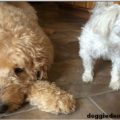Just as we prefer to instill good manners in our human children, it’s no different when it comes to our furry canine kids. Dogs and children are not so very different in the fact that they won’t know what is expected of them until they are taught. That’s where you come in, of course!
There are 5 vital commands to teach a dog in order to get a good start on instilling some good old fashioned doggie manners. These are just the basics, of course; but, after your dog has mastered these, he will surely be on a path for success to learning future commands and tricks.
(You may also want to read guidelines to ensure success when training. Additionally, it includes 10 more simple tricks to teach your dog.)
5 Vital Commands to Teach a Dog – And Why They are Important
-
Teach Your Dog To Sit
Why is it useful?
There are many useful reasons you will need your dog to understand the command “sit”. A few examples are, when guests come over (to prevent jumping), before giving treats (to prevent “snatching”), when opening doors (to prevent dashing out), at the vet (so they can get a good look), and in any situation where you want to promote a calm demeanor.
How do you teach it?
 Put a leash on your dog, and stand by his side facing the same direction.
Put a leash on your dog, and stand by his side facing the same direction.
- While holding the leash in a firm straight up position with one hand, slightly push your dog’s rear end down with the other hand. At the same time, give the command, “sit”.
- Once your dog sits, be sure to treat and give plenty of praise
- Soon you won’t need the leash, or to push your dog’s rear end.
-
Teach Your Dog To Stay
Why is it useful?
When I was a kid we had a dog that would dash out the door as soon as we opened it. It would have been useful to have properly taught the “stay” command. I now use the stay command in all kinds of situations. In example, I recently dropped some grapes (toxic for dogs) on the floor. Guess which command I used to prevent my dog from dashing after them? It’s also very useful when opening the car door to prevent the possibility of rushing out into who knows what kind of danger. This one was important to me; my dog now knows it so well, that I can give him the command, walk completely out of his sight, and I know he’ll still be in place when I return to him.
How do you teach it?
 Command your dog to “sit”.
Command your dog to “sit”.
- Facing your dog, put the palm of your hand in front of his nose and firmly say, “stay”.
- Take a step backward (if he stays praise him and offer a treat so he knows he has done what was expected of him)
- If he does not stay, do the same step over again, starting with calmly walking back, setting him up with the “sit” command, then once again, the “stay” command.
- Practice daily, and once he begins to stay, increase the length of time for the “stay”, and also the distance between the two of you.
- Make sure you release the stay position by giving a command, such as “ok”. You want to be sure that YOU make the call as to when the “stay” should be finished.
-
Teach Your Dog To Lie Down
Why is it useful?
This command works great in combination with the “stay” command. Once you get your dog to lie down, you can also command him to stay. It can help you around dinner time (to prevent begging), when guests come over (to prevent jumping, or excitement), to lie down after a surgery, or to lie down when it is time to go to bed.
How do you teach it?
 Facing your dog, give the command “sit”.
Facing your dog, give the command “sit”.
- Hold a treat in front of your dog’s nose so he can smell it, but not eat it.
- While using the command “down”, slowly begin moving the treat straight down to the ground.
- If your dog lies down, be sure to praise and offer the treat. You may need to wait a bit before your dog figures out that lying down is what gets him the treat, but just wait it out and praise and treat accordingly.
- If your dog doesn’t lie down, start over again from the beginning. Be sure you are pulling the treat straight down, and also that his nose stays with your hand in the process. Never offer the treat until he is in a complete down.
- Alternatively, if you just can’t get your dog to lie all the way down, you can use the same method, only this time sit on the ground with your knee bent. Then, when moving the treat downward you can bring it under your leg so your dog has to crawl under to get it. When you get him in a full lie down position, praise and treat…and repeat!
-
Teach Your Dog To Come
Why is it useful?
Recall is great for a lot of reasons…there are the small things, such as when it is time to eat, time to snuggle, or time to go out. But, what about those more critical times, such as when you need to round your dog up to leave the dog park, your dog bursts out of the car near a busy street, or your dog runs off to chase a squirrel? You can see why having a strong recall can become vital for safety reasons too.
How do you teach it?
 Put a leash on your dog.
Put a leash on your dog.
- Gently tug the leash toward you while giving the command, “your dog’s name” + “come”.
- When your dog reaches you be sure to offer a treat and lots of praise.
- Once your dog gets good at it, lengthen the leash to leave even more space between the two of you.
- Eventually you will be able to call your dog without the leash.
- When your dog gets good at the “come” command, you can then add the “sit” command once he reaches you. This way your dog won’t just come to snatch the treat and then take off again. Since there will be times when you need to leash your dog after he comes, you should mix up your practice sessions with sometimes rubbing him around the neck area, or gently holding his collar for a moment. But, avoid ever grabbing him roughly by the collar as this could relay a negative consequence and scare him off for next time.
- Tip: A dog will never “come” reliably if he thinks he may be in trouble, or that there will be some type of negative consequence. With that in mind, ONLY use “come” when there is a positive outcome, NEVER use it to reprimand, give medicine, or any other thing your dog doesn’t like. And NEVER use “come” in an angry voice, it must only be used when associated with something positive or it will never work reliably.
-
Teach Your Dog To Leave It
Why is it useful?
This is where you simply teach your dog to leave something alone. You can use it when your shoes are about to be chewed, you drop something that could be toxic to your dog, your dog attempts to pick up garbage while on a walk, or Fluffy the cat enters the room. If your dog gets good at it (practice, practice, practice) it could be a true life saver!
How do you teach it?
 Hold a yummy treat in your closed fist allowing your dog to sniff it, but not eat it.
Hold a yummy treat in your closed fist allowing your dog to sniff it, but not eat it.
- Let your dog paw at your fist, sniff it, or whatever the reaction, but do not let him have it. The moment he ignores the treat by backing up, staring at your fist, or turning his head, praise him while placing the treat on the floor to let them eat it. No command is necessary at this point; you are simply getting your dog used to ignoring the treat. Repeat this several times in a row until your dog fully understands that he only gets the treat if he leaves it alone.
- Next, let him see you close your fist around the treat and at the same time say, “leave it”.
- By this point your dog should already have the idea that he is not going to get the treat until he leaves it alone. When your dog does leave it alone, reward him by placing the treat on the floor and letting him eat it. Repeat this several times to ensure your dog associates the words “leave it” with leaving the treat alone.
- Next, let your dog see you place a treat on the floor, but this time cover it with your hand while giving the command “leave it”. Since this time it is on the floor, and not in your hand, your dog may paw at it for a moment or two, but when he leaves it alone, praise him and pick up the treat and set it down in front of him to eat.
- Once your dog has mastered the above steps, you will be able to set the treat on the floor without covering it up, and by using the command “leave it” your dog will understand what is expected of him.
- You will need to practice this daily, with different treats or objects, and in different locations to ensure your dog will reliably listen.





